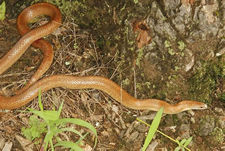A Pair of Kings
"Kingsnake" is a term familiar to many people who associate it with those snakes that, due to their immunity to snake venom and their powers of constriction, can kill and eat venomous snakes. The species most often associated with this name, and status, is a beautiful shinny black animal with narrow bright yellow or whitish cross bands. This is the Eastern kingsnake. These snakes do not purposefully hunt venomous snakes, indeed they eat many other kinds of snakes, rodents, and other items. But their earned reputation with venomous snakes provides them a welcome by many landowners who might otherwise be unfriendly to snakes. An adult Eastern kingsnake may grow to over 4 feet in length, is a handsome sight, and is correctly perceived as one of the jewels of our upstate fauna.
In addition to the Eastern kingsnake, the mole kingsnake dwells in open areas and forest edges of our upstate. Living up to its name, this species spends considerable time under ground, and seeing one in the open is a rather rare sight. Most specimens are found as they crawl across roads. The mole kingsnake grows to 3 feet and is light glossy brown with darker brown blotches. This may sound copperhead-like, but this kingsnake has a very narrow head and body quiet different from a copperhead. They feed mostly on rodents.
Both of these kingsnakes are secretive, spending much time out of sight, and therefore may live around people for years without being discovered. Then one day, there one of them is in your driveway, or on your back porch. After you get over the surprise, enjoy the visit.
 |
Eastern Kingsnake (Lampropeltis getula): shinny black with narrow yellow cross bands, 2 |
 |
Mole Kingsnake(Lampropeltis calligaster): light brown with darker brown blotches, 2 |
